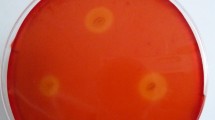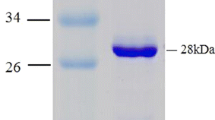Abstract
ACaulobacter crescentus epoxide hydrolase (CCEH) from a recombinantEscherichia coli was purified to homogeneity using a three-step procedure. The CCEH protein was purified 7.3-fold with a 22.9% yield in overall activity. The optimal reaction temperature and pH were determined to be 37°C and pH 8.0, respectively. The addition of 10% (v/v) dimethylsulfoxide as a cosolvent improved the enantioselectivity of CCEH for a batch kinetic resolution of racemic indene oxide.
Similar content being viewed by others
References
Choi, W. J., C. Y. Choi, J. A. De Bont, and C. A. Weijers (2000) Continuous production of enantiopure 1,2-expoxyhexane by yeast epoxide hydrolase in a two-phase membrane bioreactor.Appl. Microbiol. Biotechnol. 54: 641–646.
Choi, W. J., and C. Y. Choi (2005) Production of chiral expoxides: Epoxide hydrolase-catalyzed enantioselective hydrolysis.Biotechnol. Bioprocess Eng. 10: 167–179.
Breuer, M., K. Ditrich, T. Habicher, B. Hauer, M. Kesseler, R. Stürmer, and T. Zelinski (2004) Industrial methods for the production of optically active intermediates.Angew. Chem. Int. Ed. Engl. 43: 788–824.
Furuhashi, K., M. Shintani, and M. Takagi (1986) Effects of solvents on the production of epoxides byNocardia corallina B-276.Appl. Microbiol. Biotechnol. 23: 218–223.
Panke, S., V. de Lorenzo, A. Kaiser, B. Witholt, and M. G. Wubbolts (1999) Engineering of a stable whole-cell biocatalyst capable of (S)-styrene oxide formation for continuous two-liquid-phase applications.Appl. Environ. Microbiol. 65: 5619–5623.
Patel, R. N., C. G. McNamee, A. Banerice, J. M. Howell, R. S. Robison, and L. J. Szarka (1992) Stereoselective reduction of β-keto esters byGeotrichum candidum.Enzyme Microb. Technol. 14: 731–738.
Fretland, A. J., and C. J. Omiecinski (2000) Epoxide hydrolases: biochemistry and molecular biology.Chem. Biol. Interact. 129: 41–59.
Arand, M., B. M. Hallberg, J. Zou, T. Bergfors, F. Oesch, M. J. van der Werf, J. A. M. de Bont, T. A. Jones, and S. L. Mowbray (2003) Structure ofRhodococcus erythropolis limonene-1,2-epoxide hydrolase reveals a novel active site.EMBO J. 22: 2585–2592.
Kim, H. S., S. J. Lee, E. J. Lee, J. W. Hwang, S. Park, S. J. K. Kim, and E. Y. Lee (2005) Cloning and characterization of a fish microsomal epoxide hydrolase ofDanio rerio and application to kinetic resolution of racemic styrene oxide.J. Mol. Catal., B Enzym. 37: 30–35.
Nardini, M., I. S. Ridder, H. J. Rozeboom, K. H. Kalk, R. Rink, D. B. Janssen, and B. W. Dijkstra (1999) The X-ray structure of epoxide hydrolase fromAgrobacterium radiobacter AD1. An enzyme to detoxify harmful epoxides.J. Biol. Chem. 274: 14579–14586.
Visser, H., C. A. G. M. Weijers, A. J. J. van Ooyen, and J. C. Verdoes (2002) Cloning, characterization and heterologous expression of epoxide hydrolase-encoding cDNA sequences from yeasts belonging to the generaRhodotorula andRhodosporidium.Biotechnol. Lett. 24: 1687–1694.
Zou, J. Y., B. M. Hallberg, T. Bergfors, F. Oesch, M. Arand, S. L. Mowbray, and T. A. Jones (2000) Structure ofAspergillus niger epoxide hydrolase at 1.8 angstrom resolution: implications for the structure and function of the mammalian microsomal class of epoxide hydrolases.Structure 8: 111–122.
Kim, H. S., J.-H. Lee, S. Park, and E. Y. Lee (2004) Biocatalytic preparation of chiral epichlorohydrins using recombinantPichia pastoris expressing epoxide hydrolase ofRhodotorula glutinis.Biotechnol. Bioprocess Eng. 9: 62–64.
Lee, J. W., E. J. Lee, S. S. Yoo, S. H. Park, H. S. Kim, and E. Y. Lee (2003) Enantioselective hydrolysis of racemic styrene oxide by epoxide hydrolase ofRhodosporidium kratochvilovae SYU-08,Biotechnol. Bioprocess Eng. 8: 306–308.
Argiriadi, M. A., C. Morisseau, B. D. Hammock, and D. W. Christianson (1999) Detoxification of environmental mutagens and carcinogens: Structure-based mechanism and evolution of liver epoxide hydrolase.FASEB J. 13: A1561-A1561.
Arand, M., A. Cronin, F. Oesch, S. L. Mowbray, and T. A. Jones (2003) The telltale structures of epoxide hydrolases.Drug Metab. Rev. 35: 365–383.
Hwang, S., H. Hyun, B. Lee, Y. Yark, C. Choi, J. Han, and H. Joo (2006) Screening from the genome databases: Novel epoxide hydrolase fromCaulobacter crescentus.J. Microbiol. Biotechnol. 16: 32–36.
Osprian, I., W. Kroutil, M. Mischitz, and K. Faber (1997) Biocatalytic resolution of 2-methyl-2-(aryl) alkyloxiranes using novel bacterial epoxide hydrolases.Tetrahedron Asymmetry 8: 65–71.
Choi, W. J., E. C. Huh, H. J. Park, E. Y. Lee, and C. Y. Choi (1998) Kinetic resolution for optically active epoxides by microbial enantioselective hydrolysis.Biotechnol. Tech. 12: 225–228.
Morisseau, C., A. Archelas, C. Guitton, D. Faucher, R. Furstoss, and J. C. Baratti (1999) Purification and characterization of a highly enantioselective epoxide hydrolase fromAspergillus niger.Eur. J. Biochem. 263: 387–395.
Monterde, M. I., M. Lombard, A. Archelas, A. Cronin, M. Arand, and R. Furstoss (2004) Enzymatic transformations, Part 58: Enantioconvergent biohydrolysis of styrene oxide derivatives catalysed by theSolanum tuberosum epoxide hydrolase.Tetrahedron Asymmetry 15: 2801–2805.
Chen, C. S., Y. Fujimoto, G. Girdaukas, and C. J. Sih (1982) Quantitative analyses of biochemical kinetic resolutions of enantiomers.J. Am. Chem. Soc. 104: 7294–7299.
Botes, A. L. (1999) Affinity purification and characterization of a yeast epoxide hydrolase.Biotechnol. Lett. 21: 511–517.
Kronenburg, N. A. E., M. Mutter, H. Visser, J. A. M. de Bont, and C. A. G. M. Weijers (1999) Purification of an epoxide hydrolase fromRhodotorula gluinis.Biotechnol. Lett. 21: 519–524.
Author information
Authors and Affiliations
Corresponding author
Rights and permissions
About this article
Cite this article
Hwang, S., Hyun, H., Lee, B. et al. Purification and characterization of a recombinantCaulobacter crescentus epoxide hydrolase. Biotechnol. Bioprocess Eng. 11, 282–287 (2006). https://doi.org/10.1007/BF03026241
Received:
Accepted:
Issue Date:
DOI: https://doi.org/10.1007/BF03026241




